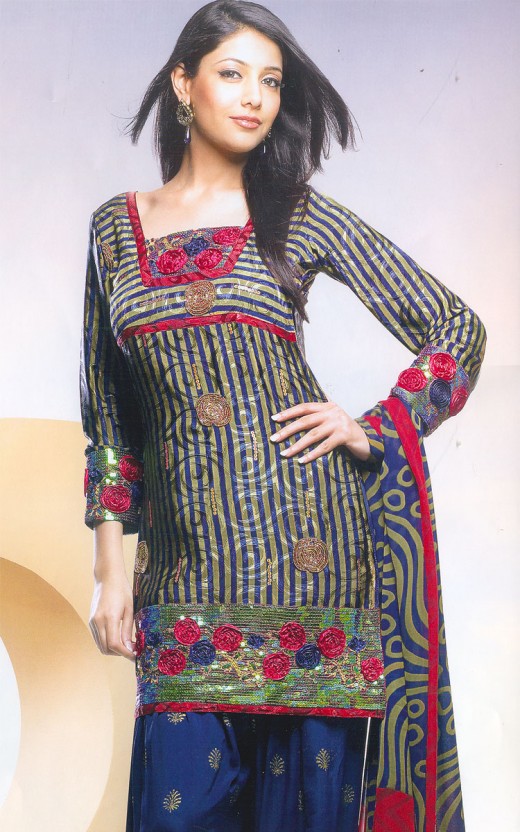Salwars Online Biography
Source (google.com.pk)Kali Salwaar (English title: The Black Garment) is a 2002 Hindi film directed by Fareeda Mehta, set in Mumbai, and starring Sadiya Siddiqui, Irrfan Khan, Kay Kay Menon, Vrajesh Hirjee in main roles. The film is based on several short stories by Saadat Hassan Manto, one of the greatest modern Urdu writers. The interior of the film is painted by Bhupen Khakhar, a famous Indian painter. The stories take place in the underbelly of Mumbai (formerly known as Bombay).
Sultana (Sadiya Siddiqui), a small town prostitute and her pimp Khudabaksh migrate to the metropolis bringing with them their dreams and meagre belongings. Initially she is bewildered by the crowds and pace of the city. With the help of Anwari (a madam or perhaps a witch) she learns how to find her bearings. As she further encounters the city and its inhabitants new perspectives open up - sad, comical, ironical but always mysterious. Sultana goes about her bright and artful seductions but somehow misses her targets. Her business collapses. Desperately, Khudabaksh too tries his hands at many jobs but is unsuccessful. His faith in his camera is replaced by his belief in a holy man. Sultana finds herself bereft and turns pensive. Her loneliness and despair get objectified in her desire for the 'kali salwaar' (black lower garment) that she needs to complete her black ensemble for the observance of mourning in Moharram.
One evening, as she solicits from her balcony she beckons a man. This man, Shankar (Irrfan Khan), inverts their relationship with his wit and worldly wisdom. The downtown and back streets where Sultana's story unfolds is peopled by 'characters' of varying hues, styles and make-up. One of these is Mohammad Bhai the 'Godfather' whose story converges with Sultana's though they never meet. Between all these people, goods, favours and money constantly change hands; and destinies are continuously transacted. From these skeins of chance meetings, seductive glances, elliptical encounters, graceful gestures and witticisms Kali Salwaar the film unfolds. Plot, colour, identities thicken and dissolve.Development
Kali Salwaar, based on the writings of Sadat Hasan Manto, marks Filmmaker Fareeda's directorial debut. An alumnus of both the Tata Institute of Social Science TISS, Mumbai from where she passed out in 1984 and the Film and Television Institute of India FTII, Pune from where she graduated with specialization in Film Direction in 1989, it has been years of hard work in getting this film across to the screen. Consciously doing away with Manto's romanticized image of being drunk and depressed and creating legendary stories of the partition, Fareeda set about creating Manto's world through his characters using a contemporary setting to let audiences relate to issues like displacement and marginalization which are very valid even today. Manto has been used as a character in the film as he flits in and out of the frame interacting with his characters. A highlight of the film are the set interiors designed by well known artist Bhupen Khakhar.
The film co-produced by Andaaz Productions and the NFDC was made on a budget of rupees 1.5 crores and merited Production Support from the Fonds Sud Cinema (The South Fund Agency of the French Ministry of Culture and Foreign Affairs which promotes cinema from southern continents), the Goeteborg Film Festival Fund from Sweden and the Hubert Bals Fund based in the Netherlands.
About the film Fareeda says, "Manto's short story Kali Salwaar ends on a note of silence. Then, for sometime, the two women had to be silent. The entire story resonated with this silence. And it seemed that this would lend itself to a cinematic exploration. Then the transformation of a short story into a feature length cinematic work. The short story form pares down detail to a minimum - to a clear lyrical flow. In scripting perhaps the reverse of this happened. Taking the bare outlines of the story I fleshed it out with concerns coincident or parallel to the events described in the short story. I brought it into a more contemporary canvas. I drew on other works of Manto. I also dialogued with filmmaking and filmmakers who have stayed with me through the years."
The colour choreography took some time to evolve. Broadly speaking the movement is from a seduction of colour to Black. Sultana's costuming was one component in this overall movement. Fareeda began with the folk colour schemes often carried by migrant labour moving to the city. The designing of costumes were derived from Mughal style-but carried to kitsch. This gave scope for layering and a play with contrast and tonalities. As with other elements in the film it was to impart a sense of being slightly 'off time.'
According to Fareeda, "Many of Bhupen Khakhar's paintings show ordinary people carrying an impenetrable sense of space about them. The colours dense and loud come together in exciting ways. Urban spaces are created with plastic pinks, sticky greens, infinite blues. The intersection of this with the narrative space desired for the film seemed promising. Bhupen generously consented and we worked on the set together. He also painted other motifs on the wall. "
Salwars Online Designs for Men Women Girls 2013 Pakistani

Salwars Online Designs for Men Women Girls 2013 Pakistani

Salwars Online Designs for Men Women Girls 2013 Pakistani
Salwars Online Designs for Men Women Girls 2013 Pakistani

Salwars Online Designs for Men Women Girls 2013 Pakistani
Salwars Online Designs for Men Women Girls 2013 Pakistani

Salwars Online Designs for Men Women Girls 2013 Pakistani
Salwars Online Designs for Men Women Girls 2013 Pakistani
Salwars Online Designs for Men Women Girls 2013 Pakistani
Salwars Online Designs for Men Women Girls 2013 Pakistani

Comments
Post a Comment